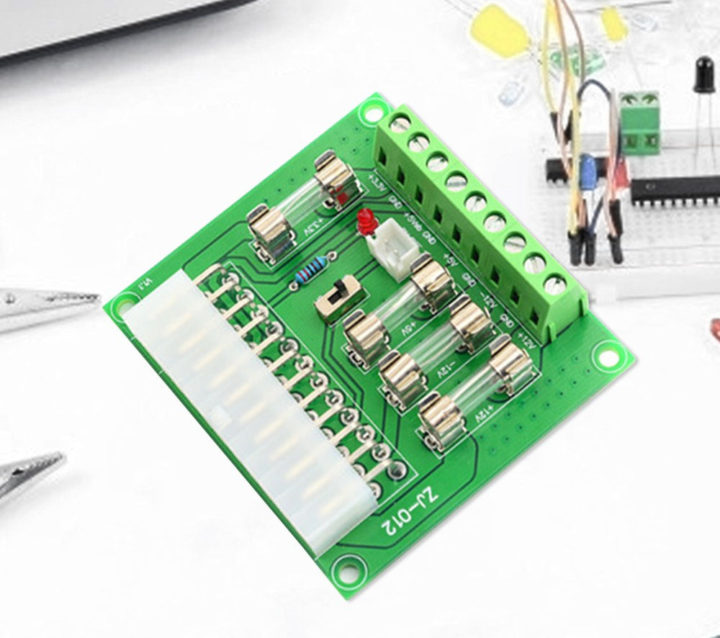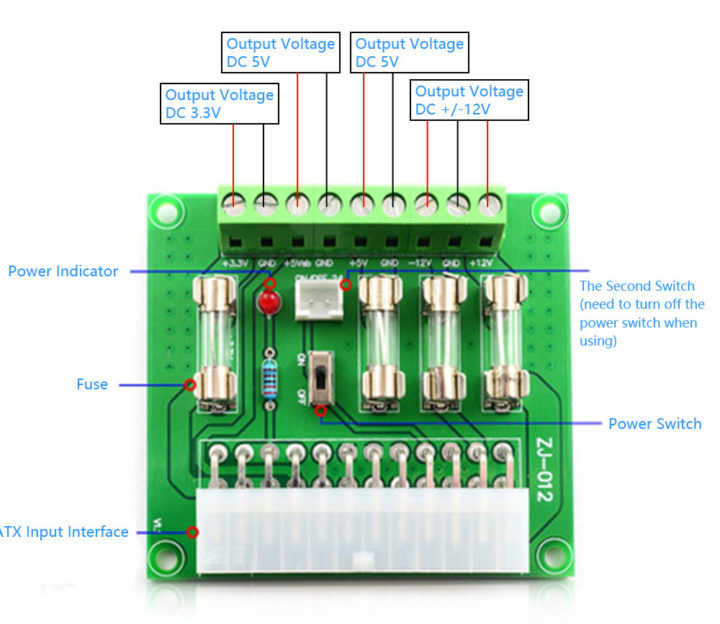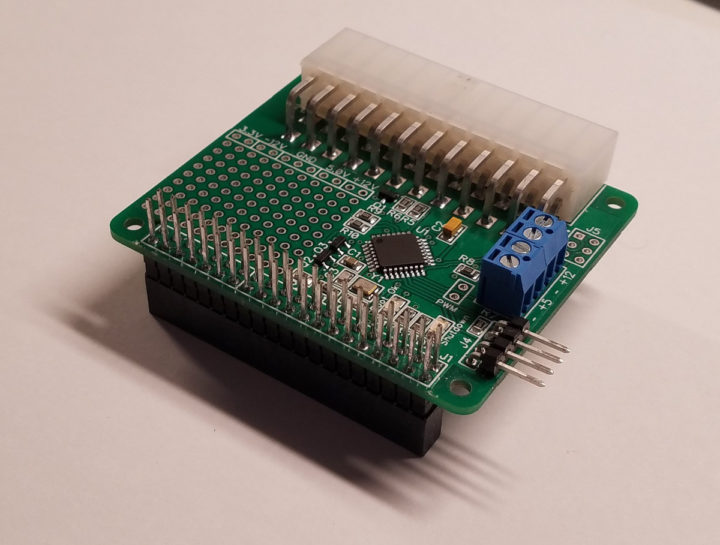Many people have ATX power supplies from older desktop PCs that they may want to reuse with Arduino boards, Raspberry Pi, or other single board computers.
It’s indeed possible to do so by trimming some cables and making a circuit to protect the board from over-voltage or over-current. But ZJ-012 adapter board offers a simpler solution with a 24-pin header for the ATX power supply, terminal blocks for connection to the target board, some fuses for protection, and a header to connect an on/off button.

- Power Input – 20-pin or 24-pin computer ATX power supply
- Power output – 9-pin terminal block with +3.3V, +5V, -12V, +12V, +5V, GND with fuses for each power outputs
- On/Off control – Toggle switch or header for external button/switch (shorted for power on)
- Misc – Power indicator (red LED)
- Dimensions – 70 x 63 x 20 mm
- Temperature Range –25°C to 85°C
- Humidity – 5%~95%RH

It’s also inexpensive, as I first found it on ICStation for about $5, but it can also be purchased on sites like Banggood or Aliexpress with the latter offering better deals for this particular board, as low as $2 plus shipping, which amounts to roughly $4-5 in total.
While looking at the subject I also noticed “Pod Bay 3″‘s mini ATX PSU II Raspberry Pi HAT designed to connect a desktop ATX power supply directly to the board. So that’s an option for a more integrated solution, but the price is quite higher starting at $26.45 on Tindie for a DIY kit.

Alternatively, if you’d prefer having the power supply to be housed in a case, it’s always possible to convert an ATX power supply into a bench power supply with some 3D printed parts.

Jean-Luc started CNX Software in 2010 as a part-time endeavor, before quitting his job as a software engineering manager, and starting to write daily news, and reviews full time later in 2011.
Support CNX Software! Donate via cryptocurrencies, become a Patron on Patreon, or purchase goods on Amazon or Aliexpress





This is an excellent idea, thanks for the tip! Much more convenient than picking wires into the ATX connector. I’ve found it on BG at $4.32 shipping included, just ordered two :-).
They also have a different model for half the price that’s more suitable as a bench supply but less for SBCs: https://www.banggood.com/fr/Geekcreit-XH-M229-Desktop-Computer-Chassis-Power-Supply-ATX-Transfer-Board-Power-Take-off-Board-Power-Output-Terminal-Module-DIY-Kit-p-1615798.html
The link does not work for me (404 not found), but I think it’s because of Banggood forcibly redirecting me to the South East Asia version of their website.
Works for UK, I just need to change language.
One of these on YouTube
https://www.youtube.com/watch?v=MG28fW-Bb4Y
Name of module: XH-M229, a lot of results on Ali.
And yes, great idea.
Yes, googling for “Geekcreit XH-M229” immediately finds it. Sorry for that, Jean-Luc, I hate posting links and that’s definitely one of the reasons.
Thanks for that link! I just ordered one. With free shipping, and the sign up bonus it cost me $0.04. Ha!
IMHO, its pretty bad idea if consider computer PSU schematics.
Modern PSUs are designed with strong +12V rails in mind. So the right thing gonna be using them with additional step-down 12->5 converters on each SBC.
The goal here is not to pull hunderds of watts from the PSU, just 2-3A from the 5V rail, or connecting a 5.5:2.1mm jack to the 12V rail to power 12V devices using 0.5-2A at best. And for these use cases the ATX PSU is well suited. One difficulty might be to turn them on as some refuse to start if you don’t pull enough juice. I used to use an old 3.5″ hard drive just for this, and it has always been sufficient. For some, even the built-in fan is enough.
Which is why I’d like to see a board like this with a bunch of 5V and 12V outputs that are individually fused. This board is a bit of a mess in that sense.
I have one of those XH-M229 type boards and it’s just this board with binding posts. It’s very poorly made–the binding posts are not high current and the PCB traces are way too narrow to carry much current. One out of the two PSUs I tried with it won’t work. 🙁
> Which is why I’d like to see a board like this with a bunch of 5V and 12V outputs that are individually fused. This board is a bit of a mess in that sense. Yes I agree with the fact that it would be better. But in this case, let’s go further an make electronic fuses with a configurable threshold, or even just current limiters. And yes I noticed that the PCB traces are particularly narrow, but for most of my use cases that’s OK. When I need to pull strong power, I don’t use such PSUs anyway, I… Read more »
Take a look at this [1], it’s more expensive but well thought out and good quality. The hardware is CC-BY-SA, there’s enough info so you can build your own.
1. ATX Breakout Board
http://dangerousprototypes.com/docs/ATX_Breakout_Board
Depending on usage, one should avoid (very) low demand on (lower efficiency) ATX power supply, because of low overall efficiency and therefore possibly increased temperature on components.
Pricewise yes, even better with possibility for connect-through of 24pin ATX connector?
If you keep a saved search on ebay or whatever you can pick up used bench supplies from decent brands like agilent for ~$50. I’ve tried stuff like this, the cheap DC-DC boards on banggood etc… Well made bench supply is definitely the way to go.
> Well made bench supply is definitely the way to go. I generally agree on this, even if a convenient use of an ATX PSU can be to have 3.3V readily available for chips like ESP8266/ESP32. I’ve always made all my bench PSUs myself since I was a kid. I’ve been missing current limiting, and tended to instead fix the parts that would fry first. One of them even managed to start a car. But that’s not suitable to SBCs, where a short circuit could instantly blow a 5mm copper track, which is why I made another smaller one, but… Read more »
I think those Chinese units are usually OK but generally have some flaw that makes them unusable long term. Like massive overshoot when first turned on.
The interfaces on them are usually aren’t very good either. Like being so complicated to use with different button hold times that it’s easy to suddenly turn the output on at the wrong voltage.
That one insists on “24hr continuous use”, not any form of guarantee but at least an attempt to address a common concern, and has true potentiometers (otherwise I wouldn’t be interested). Often another problem with such switching PSUs is that they can’t go down to zero volt, but here I suspect that the constant PSU inside that powers USB is also used to power the control logic and that they can easily go down to 0% duty cycle on the power line. The risk is likely that the input capacitors or MOSFET don’t last long… These parts are easy to… Read more »